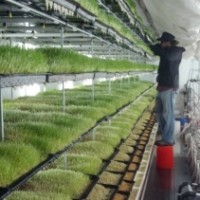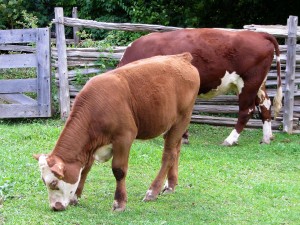

Sustainable Livestock Feed- Energy & Nutrition
 Posted by SLN Staff on Jul 16th, 2014 | Comments Off on Sustainable Livestock Feed- Energy & Nutrition
Posted by SLN Staff on Jul 16th, 2014 | Comments Off on Sustainable Livestock Feed- Energy & Nutrition 

The global demand for food is increasing every day, and therefore it has become necessary to understand the sustainable feeding methods of animal production and farming. In the next decade, farming animals and raising animals for production of food will become extremely challenging due to the climatic changes, scarcity of resources, and shortages of food and water. Animals should not compete with humans for their own sustenance. Farm animal food should be affordable and profitable, without using any unnatural ingredients, GMOs, or harmful substances that cause long or short term impact on the environment.
The feed we give our farm animals is converted into food when these animals grow. Livestock contribute to food supply by converting low value materials that are inedible by humans into high protein nutrition such as milk, meat, eggs, and other poultry and farm products.
Livestock production and Sustainability
 The livestock industry around the world is going through massive transformations today due to the huge demand of milk and meat. It is expected that over the next decade or so the demand for milk and meat in the third world nations will double. The global demand for high value foods such as fruits and vegetables are also increasing. A shift towards processed food from grains and other staple crops is also becoming popular. The huge demand of livestock and farm products around the world is due to the rapid urbanization, unplanned farming, and increase in urban population with higher income levels around the world. People are moving towards the cities more rapidly and more families are now becoming mid-income families in the urban areas.
The livestock industry around the world is going through massive transformations today due to the huge demand of milk and meat. It is expected that over the next decade or so the demand for milk and meat in the third world nations will double. The global demand for high value foods such as fruits and vegetables are also increasing. A shift towards processed food from grains and other staple crops is also becoming popular. The huge demand of livestock and farm products around the world is due to the rapid urbanization, unplanned farming, and increase in urban population with higher income levels around the world. People are moving towards the cities more rapidly and more families are now becoming mid-income families in the urban areas.
The challenge today among most farmers is to produce more meat, poultry and dairy products with limited resources. The challenge is to double the amount of farm products with limited land, less water and resources, and with minimum costs and money, all while reducing the negative impacts on the environment.
Sustainable livestock feed
 In most mixed crop–livestock systems, the main animal feed consists of crop residues. This enables animal-source foods to be produced without competing with people for food. However, another problem can arise if the crop residue is not returned to the soil. Using crop residue as feed and using animal manure as fertilizer can ensure the future crop cultivation. The importance of feeding livestock home grown feed instead of food bought from the stores or imported stuff is growing, and can address the problems associated with feed shortages.
In most mixed crop–livestock systems, the main animal feed consists of crop residues. This enables animal-source foods to be produced without competing with people for food. However, another problem can arise if the crop residue is not returned to the soil. Using crop residue as feed and using animal manure as fertilizer can ensure the future crop cultivation. The importance of feeding livestock home grown feed instead of food bought from the stores or imported stuff is growing, and can address the problems associated with feed shortages.
Feeding animals more grass and home grown products and waste than grains and soy will ensure that they grow naturally without excess body fat and that they will be naturally healthy.
Supplements
Animal productivity can often be boosted with appropriate and smart use of supplements. During the summer, supplements can reduce heat stress by digesting quicker than natural grasses and hay, encouraging microbes in the rumen to grow quickly and to provide better nutrition.
Micro-Greens
Instead of buying grass or bales of hay that can run up your feeding costs, you can easily grow your own micro-green fodders with your own DIY systems available from us. You can also buy “feed in a box” as per your requirements. Growing micro-green fodders yourself is easy and requires very little water, space, time and efforts.
Sustainable development
 The classic definition of sustainable development is “development that meets the environmental, social and economic needs of the present without compromising the ability of future generations to meet their own needs”. To make sustainable development, we need to see the world as a system that allows growth without compromising the quality of life of the future. The resources that we are using today took the earth millions of years to develop, and we are using resources 50% faster than the rate at which they are being regenerated.
The classic definition of sustainable development is “development that meets the environmental, social and economic needs of the present without compromising the ability of future generations to meet their own needs”. To make sustainable development, we need to see the world as a system that allows growth without compromising the quality of life of the future. The resources that we are using today took the earth millions of years to develop, and we are using resources 50% faster than the rate at which they are being regenerated.
By using resources more efficiently and finding sustainable and reusable sources of energy, we can conserve resources, reduce environmental impacts and develop sustainable methods.
Three ways to ensure food for all
- Increasing productivity (managing the supply side):
- Reducing waste
- Consuming more sustainable diets
Feeding animals grain and crude protein for dairy cattle is classified into categories depending on how it is digested. Protein categories include ruminally degradable and ruminally un-degradable (also known as by-pass) protein. Also, degradable protein is divided into rumen-soluble and insoluble categories. Nutritionists use chemical composition for ingredients to formulate rations that meet milk production requirements in an efficient and cost-effective way.
Feeding your livestock plenty of young and moist natural grasses, can be the best way to provide a good source of protein without causing any heat stress during the summer. Feeding them more grains, corn, soy and unnatural supplements can lead to heat stress and unnatural growth, unhealthy meat and milk production of animals.
Source: Sustainable Livestock Nutrition





